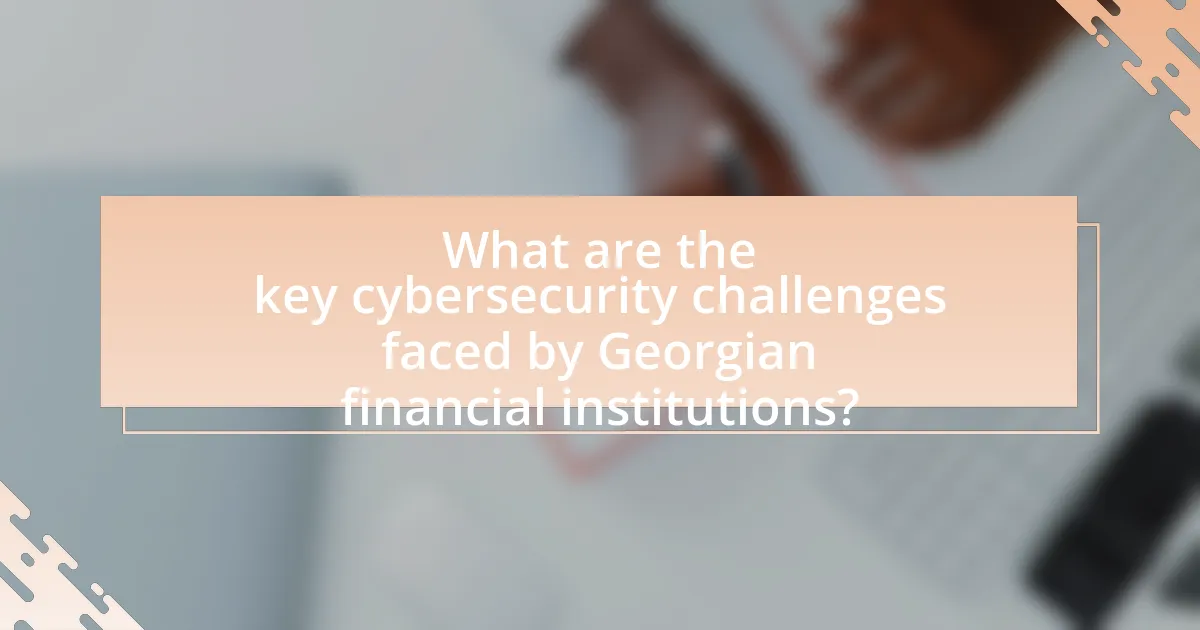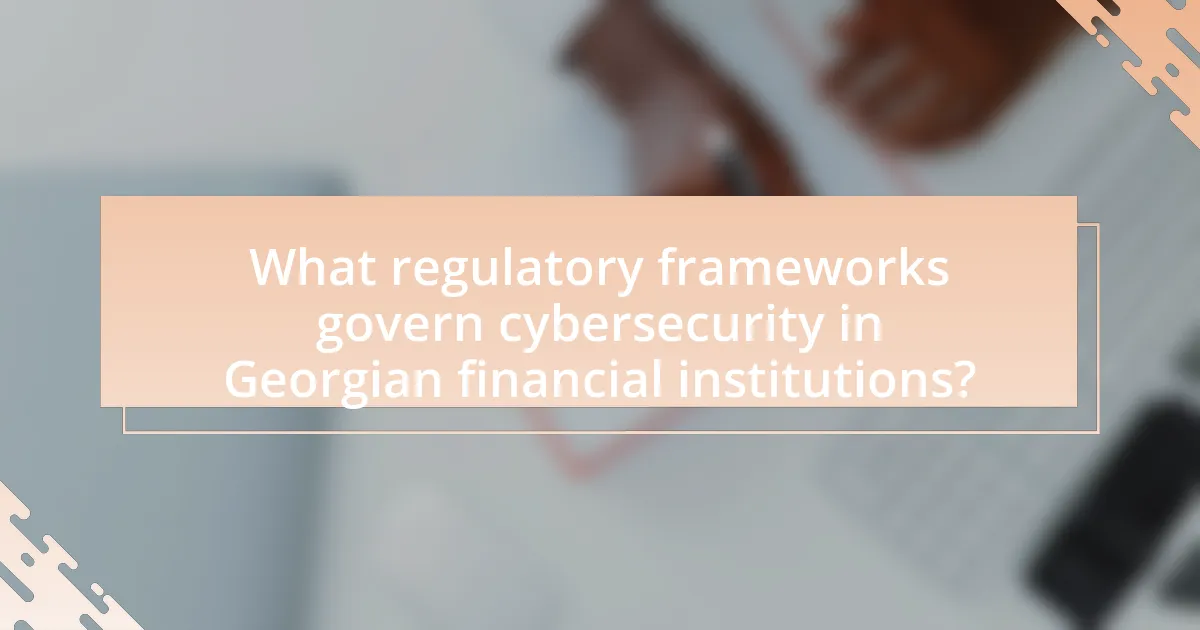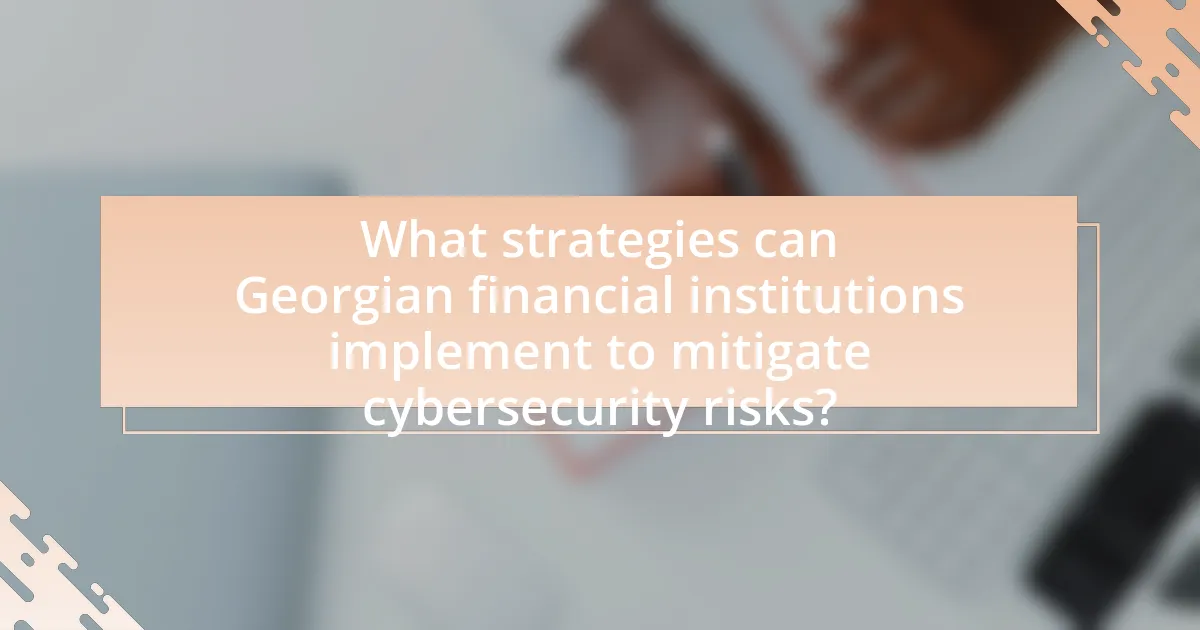Georgian financial institutions are facing significant cybersecurity challenges, including a rise in cyberattacks, regulatory compliance issues, and a shortage of skilled professionals. The prevalence of threats such as ransomware and phishing has heightened vulnerabilities, with many institutions experiencing cyber incidents that can lead to financial losses and reputational damage. Compliance with evolving regulations, such as those from the National Bank of Georgia, further complicates security efforts. This article examines the specific threats to the Georgian financial sector, the impact of these challenges on security posture, and the regulatory frameworks governing cybersecurity practices, while also outlining strategies for enhancing defenses and mitigating risks.

What are the key cybersecurity challenges faced by Georgian financial institutions?
Georgian financial institutions face several key cybersecurity challenges, including increasing cyberattacks, regulatory compliance issues, and a lack of skilled cybersecurity professionals. The rise in cyberattacks, particularly ransomware and phishing, has been significant, with reports indicating that financial institutions are prime targets due to the sensitive data they handle. Additionally, compliance with evolving regulations, such as those set by the National Bank of Georgia, poses challenges in maintaining security standards while ensuring operational efficiency. Furthermore, the shortage of skilled cybersecurity professionals in Georgia exacerbates these issues, making it difficult for institutions to effectively defend against sophisticated threats.
How do these challenges impact the overall security posture of financial institutions?
Cybersecurity challenges significantly weaken the overall security posture of financial institutions. These challenges, including increasing cyber threats, regulatory compliance issues, and inadequate security infrastructure, lead to heightened vulnerabilities. For instance, a report by the International Monetary Fund in 2022 highlighted that 70% of Georgian financial institutions experienced at least one cyber incident in the past year, underscoring the urgent need for improved security measures. Consequently, the inability to effectively address these challenges can result in financial losses, reputational damage, and regulatory penalties, further compromising the institutions’ security frameworks.
What specific threats are most prevalent in the Georgian financial sector?
The specific threats most prevalent in the Georgian financial sector include cyberattacks, fraud, and regulatory compliance issues. Cyberattacks, particularly ransomware and phishing, have increased significantly, targeting financial institutions to steal sensitive data or disrupt services. According to the National Bank of Georgia, there has been a notable rise in reported incidents of cybercrime, with financial losses amounting to millions of GEL annually. Fraud schemes, including identity theft and online scams, also pose significant risks, as they exploit vulnerabilities in digital banking systems. Additionally, regulatory compliance challenges arise from the need to adhere to evolving cybersecurity laws and standards, which can strain resources and lead to potential penalties for non-compliance.
How do these threats evolve over time?
Cybersecurity threats evolve over time through increasing sophistication and adaptability of attack methods. For instance, as financial institutions in Georgia adopt advanced technologies, cybercriminals develop more complex tactics, such as leveraging artificial intelligence for phishing attacks or exploiting vulnerabilities in new software systems. Historical data indicates that ransomware attacks have surged by over 150% in recent years, reflecting a trend where attackers continuously refine their strategies to bypass security measures. Additionally, the rise of remote work has expanded the attack surface, prompting threats to evolve from traditional network breaches to targeting endpoints and cloud services. This dynamic nature of threats necessitates ongoing vigilance and adaptation in cybersecurity strategies to effectively counteract emerging risks.
Why is cybersecurity particularly critical for financial institutions in Georgia?
Cybersecurity is particularly critical for financial institutions in Georgia due to the increasing frequency of cyberattacks targeting the sector, which can lead to significant financial losses and reputational damage. In 2022, the Georgian National Bank reported a rise in cyber incidents, highlighting vulnerabilities in the financial infrastructure. Additionally, the financial sector is a prime target for cybercriminals because it handles sensitive personal and financial data, making robust cybersecurity measures essential to protect against data breaches and fraud. The necessity for compliance with international cybersecurity standards further emphasizes the importance of effective cybersecurity strategies for these institutions in Georgia.
What are the potential consequences of cybersecurity breaches in this sector?
Cybersecurity breaches in the financial sector can lead to significant financial losses, reputational damage, and regulatory penalties. Financial institutions may face direct monetary losses due to fraud, theft, or operational disruptions, with the average cost of a data breach in the financial sector estimated at $5.85 million according to IBM’s Cost of a Data Breach Report 2022. Additionally, breaches can erode customer trust, resulting in lost business and long-term reputational harm. Regulatory bodies may impose fines and sanctions for non-compliance with data protection laws, further exacerbating financial strain. These consequences highlight the critical need for robust cybersecurity measures within Georgian financial institutions.
How does public trust in financial institutions relate to cybersecurity?
Public trust in financial institutions is directly linked to their cybersecurity measures, as consumers are more likely to engage with institutions that demonstrate robust protection against cyber threats. When financial institutions experience data breaches or cyberattacks, public confidence diminishes, leading to decreased customer loyalty and potential financial losses. For instance, a 2020 study by the Ponemon Institute found that 60% of consumers would stop using a financial service after a data breach, highlighting the critical role of cybersecurity in maintaining trust. Therefore, effective cybersecurity strategies not only protect sensitive information but also reinforce public trust, which is essential for the stability and success of financial institutions.

What regulatory frameworks govern cybersecurity in Georgian financial institutions?
The regulatory frameworks governing cybersecurity in Georgian financial institutions include the Law of Georgia on Personal Data Protection, the Law of Georgia on Electronic Communications, and the regulations set forth by the National Bank of Georgia. These frameworks establish requirements for data protection, cybersecurity measures, and compliance standards that financial institutions must adhere to in order to safeguard sensitive information and maintain operational integrity. The National Bank of Georgia, in particular, has issued specific guidelines and recommendations aimed at enhancing the cybersecurity posture of financial entities, ensuring they implement adequate risk management practices and incident response protocols.
How do these regulations shape cybersecurity practices?
Regulations shape cybersecurity practices by establishing mandatory standards and protocols that financial institutions must follow to protect sensitive data. For instance, regulations such as the General Data Protection Regulation (GDPR) and the Payment Card Industry Data Security Standard (PCI DSS) require organizations to implement specific security measures, conduct regular audits, and report breaches promptly. These requirements compel Georgian financial institutions to adopt comprehensive cybersecurity frameworks, enhancing their resilience against cyber threats. Compliance with these regulations not only mitigates risks but also fosters trust among customers, as adherence demonstrates a commitment to safeguarding personal and financial information.
What are the key regulations that financial institutions must comply with?
Financial institutions must comply with key regulations such as the General Data Protection Regulation (GDPR), the Payment Card Industry Data Security Standard (PCI DSS), and the Anti-Money Laundering (AML) laws. GDPR mandates strict data protection and privacy measures for handling personal data, while PCI DSS sets security standards for organizations that handle credit card information to prevent fraud. AML laws require financial institutions to monitor and report suspicious activities to combat money laundering and terrorist financing. Compliance with these regulations is essential for safeguarding customer data and maintaining trust in the financial system.
How do these regulations compare to international standards?
Georgian cybersecurity regulations are generally aligned with international standards, particularly those set by organizations such as the International Organization for Standardization (ISO) and the European Union’s General Data Protection Regulation (GDPR). For instance, Georgia has adopted the ISO/IEC 27001 framework, which is recognized globally for information security management systems. Additionally, the Georgian National Bank has implemented guidelines that reflect the principles of the GDPR, emphasizing data protection and privacy. These alignments demonstrate Georgia’s commitment to enhancing its cybersecurity posture in accordance with widely accepted international practices.
What role do government agencies play in enhancing cybersecurity?
Government agencies play a critical role in enhancing cybersecurity by establishing regulations, providing resources, and facilitating collaboration among stakeholders. These agencies, such as the National Cybersecurity Center, develop frameworks and guidelines that financial institutions must follow to protect sensitive data and infrastructure. For instance, in Georgia, the government has implemented the Cybersecurity Strategy, which outlines measures to strengthen the national cybersecurity posture. Additionally, government agencies often conduct training programs and simulations to prepare organizations for potential cyber threats, thereby improving overall resilience.
How effective are current government initiatives in addressing cybersecurity challenges?
Current government initiatives in addressing cybersecurity challenges are moderately effective, as they have led to the establishment of regulatory frameworks and increased funding for cybersecurity measures. For instance, the Georgian government has implemented the Cybersecurity Strategy 2021-2024, which aims to enhance the resilience of critical infrastructure and improve incident response capabilities. Additionally, the government has allocated resources to train personnel and raise public awareness about cybersecurity threats. However, challenges remain, such as the need for more robust public-private partnerships and continuous adaptation to evolving cyber threats, which indicates that while progress has been made, further improvements are necessary to fully address the complexities of cybersecurity in the financial sector.
What partnerships exist between the government and financial institutions?
Partnerships between the government and financial institutions primarily focus on enhancing cybersecurity measures. The Georgian government collaborates with financial institutions to develop frameworks and protocols aimed at protecting sensitive financial data from cyber threats. For instance, the National Bank of Georgia has established guidelines that require financial institutions to implement robust cybersecurity practices, ensuring compliance with international standards. Additionally, the government engages in information sharing initiatives, allowing financial institutions to access threat intelligence and best practices for mitigating risks. These partnerships are crucial for fostering a secure financial environment and maintaining public trust in the financial system.

What strategies can Georgian financial institutions implement to mitigate cybersecurity risks?
Georgian financial institutions can implement several strategies to mitigate cybersecurity risks, including adopting advanced threat detection systems, conducting regular security audits, and providing employee training on cybersecurity awareness. Advanced threat detection systems utilize machine learning algorithms to identify and respond to potential threats in real-time, significantly reducing the risk of data breaches. Regular security audits help identify vulnerabilities within the institution’s infrastructure, allowing for timely remediation. Furthermore, employee training programs raise awareness about phishing attacks and other social engineering tactics, which are common entry points for cybercriminals. According to a report by the International Monetary Fund, enhancing cybersecurity measures can lead to a 30% reduction in successful cyberattacks in financial sectors.
How can financial institutions enhance their cybersecurity awareness and training?
Financial institutions can enhance their cybersecurity awareness and training by implementing comprehensive training programs that include regular simulations of cyber threats, such as phishing attacks. These programs should be tailored to the specific roles within the institution, ensuring that employees understand the unique risks they face. According to a report by the Ponemon Institute, organizations that conduct regular security awareness training reduce the likelihood of a successful cyber attack by up to 70%. Additionally, integrating real-time threat intelligence into training can keep employees informed about the latest cyber threats, further strengthening the institution’s overall security posture.
What best practices should be adopted for employee training programs?
Best practices for employee training programs in the context of cybersecurity challenges for Georgian financial institutions include regular training sessions, practical simulations, and continuous assessment. Regular training sessions ensure that employees stay updated on the latest cybersecurity threats and protocols, which is crucial given the evolving nature of cyber threats. Practical simulations, such as phishing exercises, allow employees to experience real-world scenarios, enhancing their ability to recognize and respond to potential threats. Continuous assessment through quizzes and feedback mechanisms helps identify knowledge gaps and reinforces learning, ensuring that employees are well-prepared to protect sensitive information. These practices are supported by studies indicating that organizations with comprehensive training programs experience significantly fewer security breaches.
How can institutions foster a culture of cybersecurity awareness?
Institutions can foster a culture of cybersecurity awareness by implementing comprehensive training programs that educate employees about cybersecurity risks and best practices. Regular training sessions, workshops, and simulations can enhance understanding and preparedness against cyber threats. According to a study by the Ponemon Institute, organizations that conduct regular security awareness training reduce the likelihood of successful phishing attacks by 70%. Additionally, creating an open environment where employees feel comfortable reporting suspicious activities can further strengthen cybersecurity culture.
What technological solutions are available to strengthen cybersecurity defenses?
Technological solutions available to strengthen cybersecurity defenses include firewalls, intrusion detection systems (IDS), encryption, multi-factor authentication (MFA), and security information and event management (SIEM) systems. Firewalls act as barriers between trusted and untrusted networks, preventing unauthorized access. Intrusion detection systems monitor network traffic for suspicious activity, enabling timely responses to potential threats. Encryption protects sensitive data by converting it into a secure format, making it unreadable without the correct decryption key. Multi-factor authentication enhances security by requiring multiple forms of verification before granting access, significantly reducing the risk of unauthorized entry. Security information and event management systems aggregate and analyze security data from across the organization, providing real-time insights and alerts for proactive threat management. These solutions collectively enhance the cybersecurity posture of financial institutions, addressing vulnerabilities and mitigating risks effectively.
Which cybersecurity tools are most effective for financial institutions?
The most effective cybersecurity tools for financial institutions include advanced threat detection systems, endpoint protection platforms, and encryption technologies. Advanced threat detection systems, such as SIEM (Security Information and Event Management) solutions, enable real-time monitoring and analysis of security events, helping to identify and respond to potential threats quickly. Endpoint protection platforms, like EDR (Endpoint Detection and Response), provide comprehensive security for devices connected to the network, ensuring that malware and other threats are detected and mitigated. Encryption technologies safeguard sensitive data both in transit and at rest, protecting it from unauthorized access and breaches. These tools are essential for financial institutions to comply with regulatory requirements and to maintain customer trust in an increasingly digital landscape.
How can institutions leverage threat intelligence to improve their defenses?
Institutions can leverage threat intelligence to improve their defenses by integrating real-time data on emerging threats into their security protocols. This integration allows organizations to proactively identify vulnerabilities and respond to potential attacks before they occur. For instance, a study by the Ponemon Institute found that organizations utilizing threat intelligence reported a 27% reduction in the average cost of a data breach. By analyzing threat patterns and sharing intelligence across sectors, institutions can enhance their situational awareness and strengthen their overall cybersecurity posture.
What are the best practices for incident response in the event of a cybersecurity breach?
The best practices for incident response in the event of a cybersecurity breach include establishing an incident response plan, conducting regular training and simulations, and ensuring effective communication among stakeholders. An incident response plan outlines the steps to take during a breach, which is crucial for minimizing damage and restoring operations quickly. Regular training and simulations prepare the response team to act efficiently under pressure, as evidenced by studies showing that organizations with practiced response plans reduce recovery time by up to 50%. Effective communication ensures that all relevant parties, including IT, legal, and public relations, are aligned, which is essential for managing the breach’s impact and maintaining stakeholder trust.
How should financial institutions prepare for potential cybersecurity incidents?
Financial institutions should implement a comprehensive cybersecurity strategy that includes risk assessment, employee training, incident response planning, and regular system updates. Conducting a thorough risk assessment helps identify vulnerabilities and potential threats specific to the institution’s operations. Employee training is crucial, as human error is a significant factor in cybersecurity breaches; according to a report by IBM, 95% of cybersecurity incidents are caused by human mistakes. Developing an incident response plan ensures that institutions can quickly and effectively respond to breaches, minimizing damage and recovery time. Regular system updates and patch management are essential to protect against known vulnerabilities, as outdated systems are often targeted by cybercriminals.
What steps should be taken immediately following a breach?
Immediately following a breach, organizations should contain the breach to prevent further unauthorized access. This involves isolating affected systems, changing passwords, and disabling compromised accounts. Next, organizations must assess the extent of the breach by identifying what data was accessed or stolen, which is crucial for understanding the impact. Following this, notifying relevant stakeholders, including affected individuals and regulatory bodies, is essential to comply with legal obligations and maintain transparency. Finally, organizations should conduct a thorough investigation to determine the cause of the breach and implement measures to prevent future incidents, as evidenced by the fact that 60% of companies that experience a breach fail to implement adequate security measures afterward, according to a study by the Ponemon Institute.
What practical steps can Georgian financial institutions take to enhance their cybersecurity posture?
Georgian financial institutions can enhance their cybersecurity posture by implementing a multi-layered security framework that includes regular risk assessments, employee training, and advanced threat detection systems. Regular risk assessments help identify vulnerabilities and prioritize security measures, while employee training ensures that staff are aware of phishing attacks and other cyber threats. Advanced threat detection systems, such as intrusion detection and prevention systems, can monitor network traffic for suspicious activity, thereby reducing response times to potential breaches. According to the 2021 Cybersecurity Report by the International Monetary Fund, financial institutions that adopt comprehensive cybersecurity strategies can reduce the likelihood of successful cyberattacks by up to 70%.